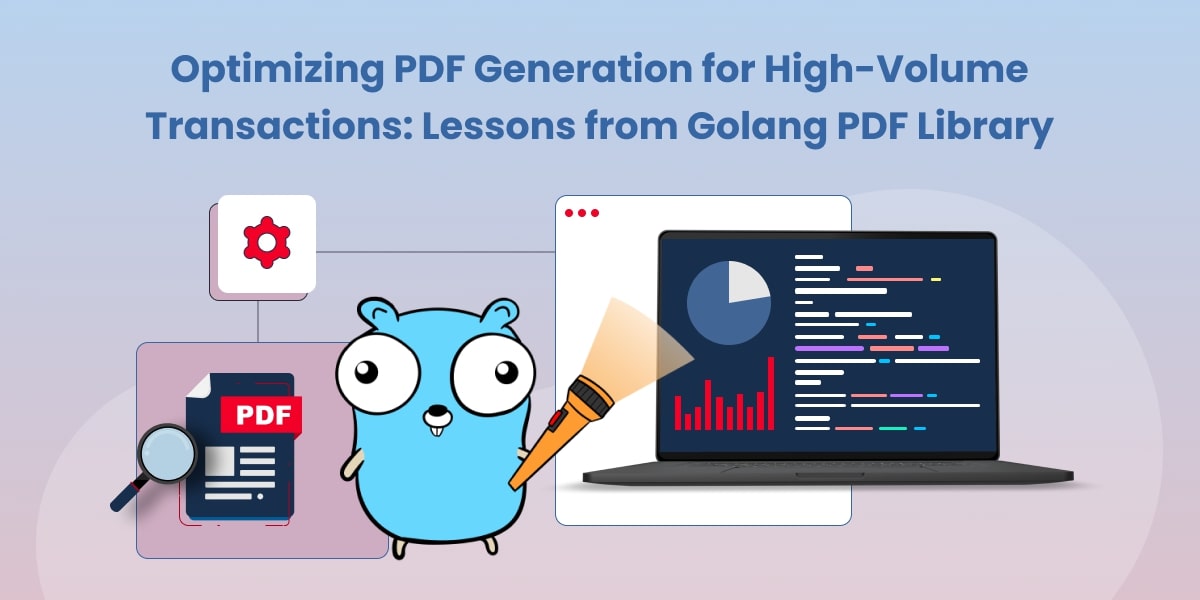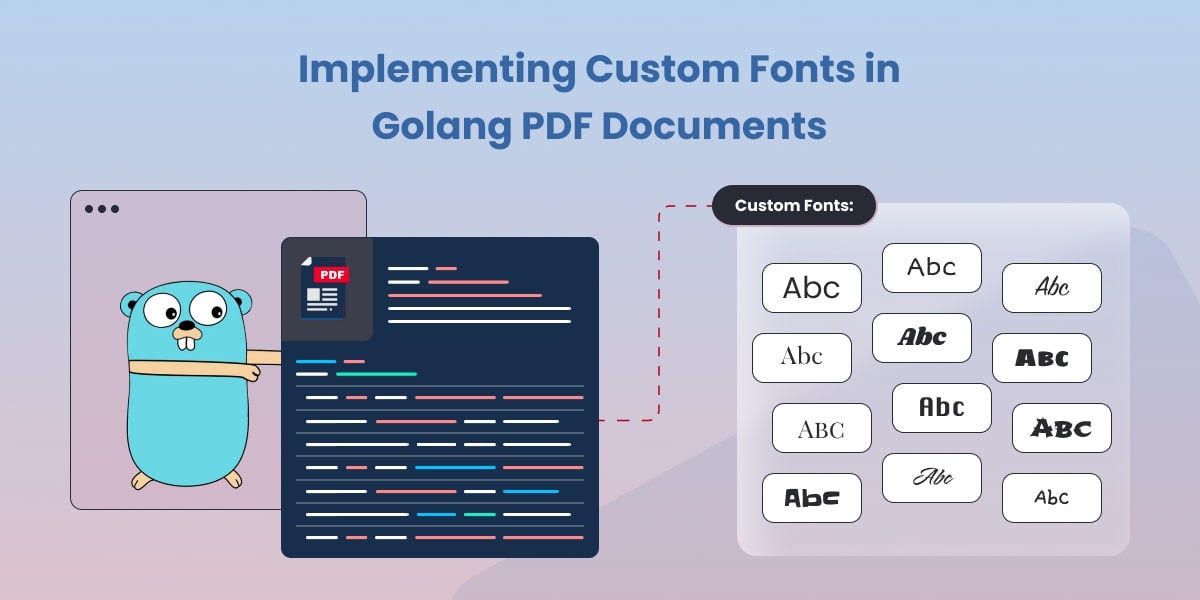Optimizing PDF Generation for High-Volume Transactions: Golang Guide

Are you a user of UniPDF, the powerful Golang PDF library? If so, you’re probably already aware of the importance of optimizing PDF generation for high-volume transactions.
In this blog post, we’ll explore some valuable lessons learned from using the Golang PDF library to optimize the generation of PDFs for large-scale transactions.
So, let’s dive in and discover how to enhance your PDF generation process for improved efficiency and performance.
1. Understanding the Importance of Optimization
When dealing with high-volume transactions, such as generating numerous PDF documents simultaneously, optimization becomes paramount. Efficient PDF generation not only saves time but also improves overall system performance.
By understanding the significance of optimization, you can ensure smooth operations and better user experiences.
2. Leveraging the Power of Golang PDF Library
The Golang PDF library, like UniPDF, offers a wide range of functionalities that can immensely simplify and streamline the PDF generation process. By utilizing the library’s features effectively, you can optimize your workflow and boost productivity.
It is crucial to familiarize yourself with the library’s documentation and explore the available methods that cater specifically to high-volume PDF generation.
3. Implementing Best Practices for High-Volume PDF Generation
To optimize PDF generation for high-volume transactions, it is essential to implement certain best practices. Here are a few techniques you can employ:
Use Templates and Predefined Styles:
Utilize predefined templates and stylesheets to standardize the appearance of generated PDFs. This reduces the processing time required to create each document and ensures consistency across large batches.
Batch Processing:
Consider grouping similar tasks into batches to reduce overhead. Processing multiple PDF generation requests at once minimizes resource consumption and enhances overall efficiency.
Avoid Resource Intensive Operations:
Optimize resource-intensive operations, such as image handling and font embedding. Compressing images, using appropriate image formats, and selectively embedding fonts can significantly reduce the file size and processing time.
Caching:
Implement caching mechanisms to store frequently used resources, such as fonts or images, in memory. Caching eliminates redundant disk access, resulting in faster generation times for subsequent PDFs.
4. Monitoring and Fine-Tuning Performance
After implementing optimization techniques, it is crucial to continuously monitor and fine-tune your PDF generation process to ensure consistent performance. Here are a few tips:
Logging and Error Handling:
Implement a robust logging and error handling system to identify potential bottlenecks or issues. Monitor logs regularly to detect any anomalies and address them promptly.
Performance Testing:
Regularly conduct performance tests to measure the efficiency of your PDF generation process. This helps identify areas that require further optimization and ensures smooth operations even under high load conditions.
Continuous Improvement:
Take advantage of feedback from users and stakeholders to improve your PDF generation workflow continuously. Embrace an iterative approach that allows for enhancements based on real-world scenarios and user experiences.
The PDF Generation Challenge
Imagine a scenario where an e-commerce giant processes thousands of orders per minute. Each order requires a personalized invoice or receipt in PDF format. This presents a significant challenge when it comes to generating PDFs efficiently and swiftly.
Traditional PDF generation methods might struggle to keep up with such high demand, leading to bottlenecks, delays, and an overall negative impact on user experience.
Lesson 1: Concurrency is Key
One of the fundamental principles behind the Golang PDF library’s success is its robust support for concurrency. Golang’s native concurrency features empower developers to handle multiple tasks concurrently, resulting in faster PDF generation.
By breaking down the PDF generation process into smaller, independent tasks, developers can capitalize on the full processing power of modern multi-core systems. This not only optimizes resource utilization but also ensures a seamless user experience even during peak transaction loads.
Lesson 2: Efficient Memory Management
High-volume PDF generation can quickly consume a significant amount of memory, leading to performance degradation and potential crashes. The Golang PDF library excels in memory management, allowing developers to generate PDFs while minimizing memory footprint.
The library’s intelligent memory allocation and garbage collection mechanisms prevent memory leaks and ensure that resources are used judiciously. This enables businesses to generate PDFs at scale without compromising stability.
Lesson 3: Template Reusability
In a high-volume transaction environment, generating PDFs with dynamic content is a common requirement. The Golang PDF library enables developers to create reusable templates that can be populated with dynamic data on the fly.
By separating the layout and structure of the PDF from its content, businesses can achieve consistency in branding and design across all generated documents. This also streamlines the PDF generation process by eliminating the need to recreate the entire document for each transaction.
Lesson 4: Caching and Preprocessing
To further enhance PDF generation speed, the Golang PDF library supports caching and preprocessing of commonly used elements. For instance, static elements like logos, headers, and footers can be preloaded and reused across multiple PDFs.
By reducing redundant computations, businesses can significantly improve PDF generation efficiency and response times. This approach proves especially valuable when dealing with repetitive content in high-volume transactions.
Conclusion
Optimizing PDF generation for high-volume transactions is vital to ensure efficient operations and enhance user satisfaction. By leveraging the power of the Golang PDF library, implementing best practices, and monitoring performance, you can optimize your workflow and achieve exceptional results.
As we continue to navigate the ever-evolving landscape of technology and business, the lessons from the Golang PDF library serve as a beacon of guidance for achieving unparalleled efficiency and performance in PDF generation.
FAQ’s
What are the key benefits of optimizing PDF generation for high-volume transactions?
Optimizing PDF generation saves time, improves overall system performance, and enhances user experiences.
How can the Golang PDF library help streamline the PDF generation process?
The Golang PDF library offers a range of functionalities and features that simplify the PDF generation process, improving productivity and efficiency.
Why is continuous improvement important in optimizing PDF generation?
Continuous improvement allows for enhancements based on user feedback and real-world scenarios, ensuring a consistently optimized PDF generation workflow.


